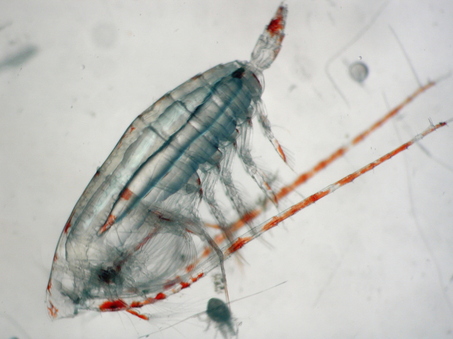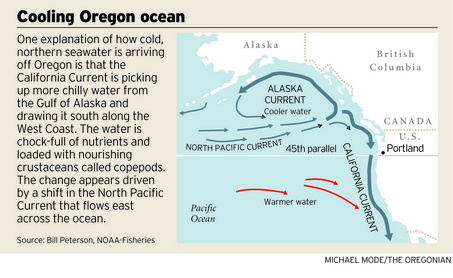forum
library
tutorial
contact

Cold Water Rejuvenates
Oregon Ocean, Salmon
by Michael MilsteinThe Oregonian, September 8, 2008
|
the film forum library tutorial contact |

|
Cold Water Rejuvenates
by Michael Milstein |
 NEWPORT -- As fishing communities suffer through the first nearly complete closure of ocean salmon catches, some good news is surfacing off the coast: The Oregon ocean is once again booming with life.
NEWPORT -- As fishing communities suffer through the first nearly complete closure of ocean salmon catches, some good news is surfacing off the coast: The Oregon ocean is once again booming with life.
A flush of cold northern water, rich with food, is nurturing a dramatic turnaround in ocean conditions this year, marine experts say. The situation contrasts with poor offshore conditions in recent years that left fish and birds desperate for food and probably contributed to the collapse of Sacramento River salmon, a keystone of Oregon's salmon fishery.
"This will be the year that saves a lot of fisheries," said Bill Peterson, an oceanographer based at Newport's Hatfield Marine Science Center with the NOAA-Fisheries, the federal agency that monitors oceans.
The dose of chilly water from the Gulf of Alaska may also be what is bringing an odd mix of sea creatures onto Oregon's shores this summer. They include young salmon sharks -- a relative of the great white that feeds on salmon -- and a robust clubhook squid, the third-largest squid in the ocean, measuring up to 13 feet long.
Also, the eerie "dead zones" that suffocated marine life along the coast in recent summers have been less pronounced this year, Oregon State University scientists said.
But the biggest payoff could come in the form of rebounding salmon stocks.
It will take some time, though, especially for Sacramento River salmon, which plummeted sharply in recent years, leading to a nearly complete closure of West Coast salmon fishing this summer. Unusually warm conditions, especially off Northern California in 2005, delayed the upwelling of nutrients, and the ocean food chain collapsed -- leaving young salmon little to eat.
 That hammered the Sacramento fish so hard they might need more time to rebuild, Peterson said.
That hammered the Sacramento fish so hard they might need more time to rebuild, Peterson said.
Because salmon live at sea for more than a year, fish benefiting from this year's resurgence won't return to their home rivers in California and Oregon right away, Peterson said. Next year, though, coho salmon returns should be strong, followed by chinook returns in 2010.
"All the signs are there for a recovery of salmon stocks," he said, describing his outlook as "guardedly optimistic."
The ups and downs in salmon numbers have underscored how little scientists know about factors that can dramatically affect one of the West Coast's most valuable fish during its time at sea. Different salmon stocks use different parts of the ocean, which may explain why some flourish even as others plummet.
Sacramento River fish make up about 80 percent of fish caught off the Oregon coast in summer, so they are heavily influenced by conditions here.
Peterson has identified a series of ocean and climate conditions -- such as temperature, salinity, upwelling and food supply -- that affect salmon. He has combined them into a system of indicators that he hopes will provide better advance signals of salmon declines or upsurges.
The system is now signaling more positive salmon returns than it has in more than 10 years.
The undersea current of cold water from the Gulf of Alaska is pumping Oregon's ocean full of fat little copepods, tiny crustaceans that form the base of the marine food chain, Peterson said. The main species of copepod from the north is about three times the size of more southern species that would otherwise dominate, which adds an extra dose of nutrition to the offshore ecosystem.
"You get this kind of river of animals fed to everything that's here," Peterson said.
Offshore netting surveys in June turned up more juvenile salmon, including three times more spring chinook, than ever before in the 11 years crews have done the surveys, Peterson said. That often presages strong salmon returns in coming years.
The inflow of northern water has kept the Oregon ocean around 46 degrees, colder than any year since 1999, Peterson said. This may signal a new cool phase in an ocean temperature pattern known as the Pacific Decadal Oscillation. Cold water is generally good for salmon because it tends to hold more nutrients.
Tuna, on the other hand, favor warmer water. Last year fishermen caught tuna within 15 miles of shore, a sign the water was warm, said William Hanshumaker, a public marine education specialist at the Hatfield Marine Science Center. This year, tuna are staying around 50 miles offshore, an indication the near-shore waters have gone cold.
A giant robust clubhook squid washed ashore just north of Yachats earlier this summer. The squid rarely appear on Oregon beaches. A public dissection of the squid will take place at the Hatfield Marine Science Center Jan. 10.
Odd fish have washed ashore this summer, perhaps influenced by the changing conditions. Hanshumaker said the creatures include lancetfish, which resemble barracudas. He has heard of seven baby salmon sharks washing up in the past two weeks.
The sharks get attention because they resemble young great whites.
The northern water arriving off Oregon is especially rich because La Nina climate conditions, characterized by lower water temperatures, helped mix the water, said Jack Barth, a professor of oceanography at Oregon State University. That helped draw more nutrients up from the depths.
"The source water is better than average," he said.
The cold, sub-Arctic water holds less oxygen, which could prove negative for ocean life if compounded by the appearance of dead zones. Dead zones have appeared unusually close to shore along the Oregon coast in recent years, often driven by strong local upwelling of nutrient-rich water that causes explosions of tiny marine organisms.
The decay of those organisms then sucks oxygen from the surrounding water, suffocating marine life such as starfish and crabs -- though fish seem to move fast enough to escape.
There was some evidence of hypoxia -- a deadly lack of oxygen -- early in the summer, said Francis Chan, a marine ecologist at OSU. But moderate summer weather punctuated by cool periods appears to have kept the upwelling from going into overdrive and creating more severe hypoxic conditions, he said.
But he cautioned that the summer's not over and that there's still time for hypoxic conditions to appear. Federal crews will conduct offshore surveys to better measure how oxygen conditions influence fish.
learn more on topics covered in the film
see the video
read the script
learn the songs
discussion forum
